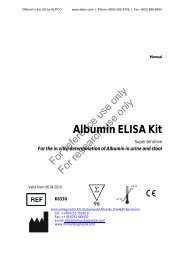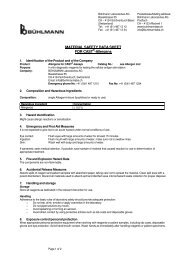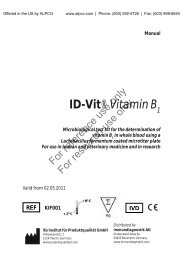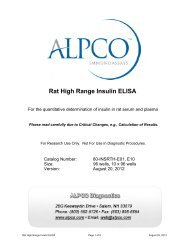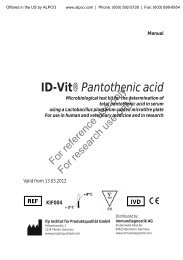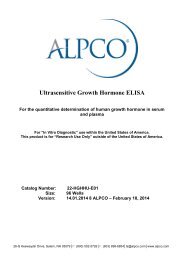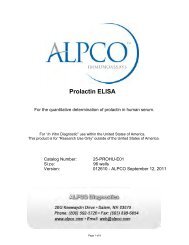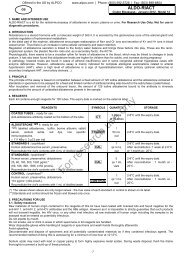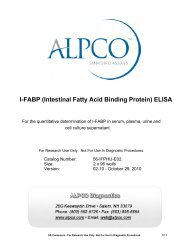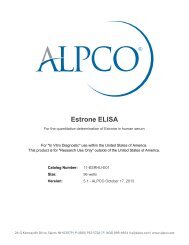Ultrasensitive TNF-alpha ELISA - ALPCO Diagnostics
Ultrasensitive TNF-alpha ELISA - ALPCO Diagnostics
Ultrasensitive TNF-alpha ELISA - ALPCO Diagnostics
You also want an ePaper? Increase the reach of your titles
YUMPU automatically turns print PDFs into web optimized ePapers that Google loves.
with a large volume of water to prevent azide accumulation. Avoid ingestion and contact witheyes, skin and mucous membranes. In case of contact, rinse affected area with plenty of water.Observe all federal, state and local regulations for disposal.SUPPLIES REQUIRED BUT NOT PROVIDED1. Microtiter plate reader capable of measurement at or near 450 nm.2. Calibrated adjustable precision pipettes, preferably with disposable plastic tips. (A manifoldmulti-channel pipette is desirable for large assays.)3. Distilled or deionized water.4. Plate washer: automated or manual (squirt bottle, manifold dispenser, etc.).5. Data analysis and graphing software. Graph paper: linear (Cartesian), log-log, or semi-log, asdesired.6. Glass or plastic tubes for diluting and making standard aliquots.7. Absorbent paper towels.8. Calibrated beakers and graduated cylinders in various sizes.9. 37°C incubator.PROCEDURAL NOTES/LAB QUALITY CONTROL1. When not in use, kit components should be refrigerated. All reagents should be warmed toroom temperature before use.2. Microtiter plates should be allowed to come to room temperature before opening thefoil bags. Once the desired number of strips has been removed, immediately reseal the bagand store at 2 to 8°C to maintain plate integrity.3. Samples should be collected in pyrogen/endotoxin-free tubes. Samples should befrozen if not analyzed shortly after collection. Avoid multiple freeze-thaw cycles offrozen samples. Thaw completely and mix well prior to analysis.4. When possible, avoid use of badly hemolyzed or lipemic sera. If large amounts ofparticulate matter are present, centrifuge or filter prior to analysis.5. It is recommended that all standards, controls and samples be run in duplicate.6. Samples that are >32 pg/mL should be diluted with Standard Diluent Buffer.7. When pipetting reagents, maintain a consistent order of addition from well-to-well. Thisensures equal incubation times for all wells.8. Cover or cap all reagents when not in use.9. Do not mix or interchange different reagent lots from various kit lots.10. Do not use reagents after the kit expiration date.11. Read absorbances within 2 hours of assay completion.12. In-house controls should be run with every assay. If control values fall outsidepre-established ranges, the accuracy of the assay is suspect.13. All residual wash liquid must be drained from the wells by efficient aspiration or bydecantation followed by tapping the plate forcefully on absorbent paper. Never insertabsorbent paper directly into the wells.14. Because Stabilized Chromogen is light sensitive, avoid prolonged exposure to light. Alsoavoid contact between Stabilized Chromogen and metal, or color may develop.SAFETYAll blood components and biological materials should be handled as potentially hazardous.Follow universal precautions as established by the Centers for Disease Control and Preventionand by the Occupational Safety and Health Administration when handling and disposing ofinfectious agents.3/9



